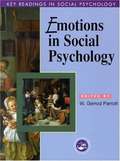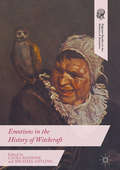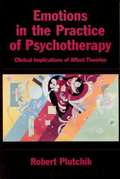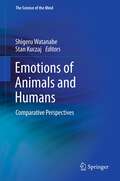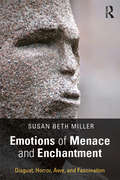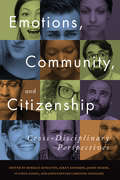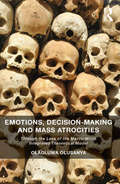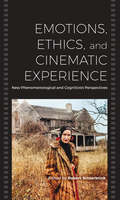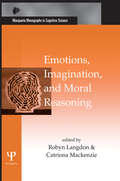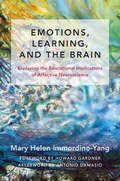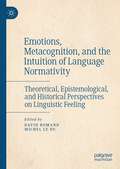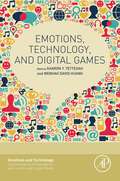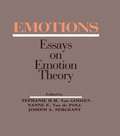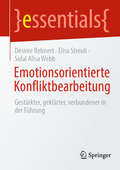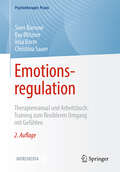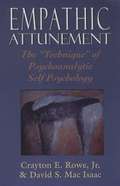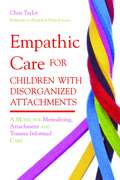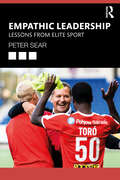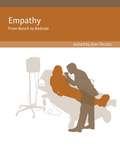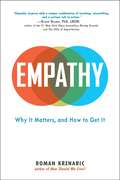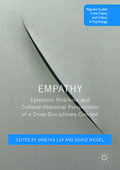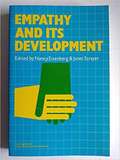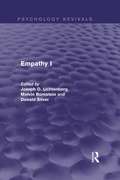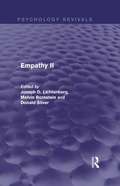- Table View
- List View
Emotions in Social Psychology: Essential Readings
by W. Gerrod ParrottSocial psychology evolves around emotions. Not only has social psychology contributed enormously to theory and research on the nature of emotions, it also has emotions at the heart of its basic subject matter, from attitudes to aggression.
Emotions in the History of Witchcraft
by Laura Kounine Michael OstlingBringing together leading historians, anthropologists, and religionists, this volume examines the unbridled passions of witchcraft from the Middle Ages to the present. Witchcraft is an intensely emotional crime, rooted in the belief that envy and spite can cause illness or even death. Witch-trials in turn are emotionally driven by the grief of alleged victims and by the fears of magistrates and demonologists. With examples ranging from Russia to New England, Germany to Cameroon, chapters cover the representation of emotional witches in demonology and art; the gendering of witchcraft as female envy or male ra≥ witchcraft as a form of bullying and witchcraft accusation as a form of therapy; love magic and demon-lovers; and the affective memorialization of the "Burning Times" among contemporary Pagan feminists. Wide-ranging and methodologically diverse, the book is appropriate for scholars of witchcraft, gender, and emotions; for graduate or undergraduate courses, and for the interested general reader.
Emotions in the Practice of Psychotherapy
by Robert PlutchikThe circumplex model of emotions has been an extremely valuable paradigm for understanding personality, psychopathology, and interpersonal relations over the past 30 years. In this volume, Robert Plutchik extends his model to inform the practice of psychotherapy across all theoretical orientations and therapeutic modalities. Beginning with a description of the role of emotions in symptom formation, Plutchik demonstrates how the circumplex model has relevance not only to emotions, but to personality traits, personality disorders, and ego defenses as well. He presents a unique compendium of therapist tactics for uncovering emotions and encouraging their expression. He examines the many distinctions between social conversation and therapeutic communication and describes specific strategies of intervention found to be helpful to therapeutic enterprise.
Emotions of Animals and Humans
by Shigeru Watanabe Stan KuczajThis book takes a multidisciplinary approach to emotion, with contributions from biologists, psychologists, neuroscientists, robot engineers, and artists. A wide range of emotional phenomena is discussed, including the notion that humans' sophisticated sensibility, as evidenced by our aesthetic appreciation of the arts, is based at least in part on a basic emotional sensibility that is found in young children and perhaps even some non-human animal species. As a result, this book comprises a unique comparative perspective on the study of emotion. A number of chapters consider emotions in a variety of animal groups, including fish, birds, and mammals. Other chapters expand the scope of the book to humans and robots. Specific topics covered in these chapters run the gamut from lower-level emotional activity, such as emotional expression, to higher-level emotional activity, such as altruism, love, and aesthetics. Taken as a whole, the book presents manifold perspectives on emotion and provides a solid foundation for future multidisciplinary research on the nature of emotions.
Emotions of Menace and Enchantment: Disgust, Horror, Awe, and Fascination
by Susan Beth MillerEmotions of Menace and Enchantment examines four pivotal human emotions. It explores what defines these emotions, how they interact, and how they impact the experience of self-boundary. All four feelings speak to the boundary around the self, to whether we stiffen that boundary, relax it or worry about its fraying. Psychoanalysis has looked closely at conflicts that human beings experience, but has paid relatively less attention to the specific emotions through which conflict is known and managed. The disgust emotion is unique in operating like a gatekeeper that manages what approaches us closely. Disgust appears prominently in our relationship with the physical world, but surprisingly, is just as common in the world of politics. It moves people to action, including deeds of great violence. Horror occurs when we feel invaded and altered by something that leads to profound insecurity. Human beings behaving inhumanly is one common source of horror. While disgust is a moral emotion, horror makes no judgments but speaks to the misery of being unsafe. Awe opens the self to the outside world, and creates moments that sustain us through times of stress. Fascination also involves openness but its characteristic attitude and attention shows its differences from awe. It forms the foundation for deep learning. All four emotions find their way into psychopathology; for example, fascination plays a role in addiction and awe in masochism and cult formation. Emotions of Menace and Enchantment will help mental health professionals in psychoanalysis, psychotherapy, psychiatry and social work to better parse clinical encounters with the four emotions and to think as well about defensive patterns aimed at blunting contact with them. It will engage anyone interested in examining the roles these emotions play in politics, societal violence, addictions, and everyday joys and suffering.
Emotions, Community, and Citizenship: Cross-Disciplinary Perspectives
by James Mckee Constantine Vassiliou Kiran Banerjee Rebecca Kingston Yi-Chun ChienEmotions are at the very heart of individual and communal actions. They influence our social and interpersonal behaviour and affect our perspectives on culture, history, politics, and morality. Emotions, Community, and Citizenship is a pioneering work that brings together scholars from an array of disciplines in order to challenge and unite the disciplinary divides in the study of emotions. These carefully selected studies highlight how emotions are studied within various disciplines with particular attention to the divide between naturalistic and interpretive approaches. The editors of this volume have provided a nuanced and insightful introduction and conclusion which provide not only an overarching commentary but a framework for the interdisciplinary approach to emotion studies.
Emotions, Decision-Making and Mass Atrocities: Through the Lens of the Macro-Micro Integrated Theoretical Model
by Olaoluwa OlusanyaThis book rehumanizes perpetrators of mass atrocities. At present a victim/perpetrator dichotomy appears to be the dominant paradigm: perpetrators have either been ’mechanistically dehumanized’, that is, perceived as unemotional, hard-hearted and conforming and thereby lacking the core features of human nature or alternatively, they have been ’animalistically dehumanized’. In other words they are seen as immoral, unintelligent, lacking self-control and likened to animals. Within sociology and criminology the dominant view is that genocide and other mass atrocities are committed by technologically-lobotomized perpetrators. Somehow the process of rationalization is believed to have transformed these people from emotionally healthy people into hollow soulless shells of human beings or zombies, devoid of a full range of normal emotions. These people are considered bereft of any ability to reason, think or feel, yet ambulant and able to respond to surrounding stimuli. However it is difficult to imagine crime (especially those involving a group of people working together for the duration of a particular criminal activity) without emotions. For instance, there is ample evidence suggesting that both crimes of passion and pre-meditated crimes involve emotional arousal. Furthermore, research in fields such as evolutionary biology, psychology and sociology of work and organizations suggest that emotions are essential for human progress and survival. In addition, emotions help us make the right call in risky and uncertain situations, in other words, the majority of real life situations. There is, therefore, a need to revisit existing assumptions around the role of emotions in mass atrocities.
Emotions, Ethics, and Cinematic Experience: New Phenomenological and Cognitivist Perspectives
by Robert SinnerbrinkSince the early 1990s, phenomenology and cognitivism have become two of the most influential approaches to film theory. Yet far from being at odds with each other, both approaches offer important insights on our subjective experience of cinema. Emotions, Ethics, and Cinematic Experience explores how these two approaches might work together to create a philosophy of film that is both descriptively rich and theoretically productive by addressing the key relationship between cinematic experience, emotions, and ethics.
Emotions, Imagination, and Moral Reasoning (Macquarie Monographs in Cognitive Science)
by Robyn Langdon Catriona MackenzieThis volume brings together philosophical perspectives on emotions, imagination and moral reasoning with contributions from neuroscience, cognitive science, social psychology, personality theory, developmental psychology, and abnormal psychology. The book explores what we can learn about the role of emotions and imagination in moral reasoning from psychopathic adults in the general community, from young children, and adolescents with callous unemotional traits, and from normal child development. It discusses the implications for philosophical moral psychology of recent experimental work on moral reasoning in the cognitive sciences and neurosciences. Conversely, it shows what cognitive scientists and neuroscientists have still to learn from philosophical perspectives on moral reasoning, moral reflection, and moral responsibility. Finally, it looks at whether experimental methods used for researching moral reasoning are consistent with the work in social psychology and with philosophical thought on adult moral reasoning in everyday life. The volume's wide-ranging perspectives reflect the varied audiences for the volume, from students of philosophy to psychologists working in cognition, social and personality psychology, developmental psychology, abnormal psychology, and cognitive neuroscience.
Emotions, Learning, and the Brain: Exploring the Educational Implications of Affective Neuroscience (The Norton Series on the Social Neuroscience of Education)
by Antonio Damasio Howard Gardner Mary Helen Immordino-YangAn orientation to affective neuroscience as it relates to educators. In this ground-breaking collection, Mary Helen Immordino-Yang--an affective neuroscientist, human development psychologist, and former public school teacher--presents a decade of work with the potential to revolutionize educational theory and practice by deeply enriching our understanding of the complex connection between emotion and learning. With her signature talent for explaining and interpreting neuroscientific findings in practical, teacher-relevant terms, Immordino-Yang offers two simple but profound ideas: first, that emotions are such powerful motivators of learning because they activate brain mechanisms that originally evolved to manage our basic survival; and second, that meaningful thinking and learning are inherently emotional, because we only think deeply about things we care about. Together, these insights suggest that in order to motivate students for academic learning, produce deep understanding, and ensure the transfer of educational experiences into real-world skills and careers, educators must find ways to leverage the emotional aspects of learning. Immordino-Yang has both the gift for captivating readers with her research and the ability to connect this research to everyday learning and teaching. She examines true stories of learning success with relentless curiosity and an illuminating mixture of the scientific and the human. What are feelings, and how does the brain support them? What role do feelings play in the brain's learning process? This book unpacks these crucial questions and many more, including the neurobiological, developmental, and evolutionary origins of creativity, facts and myths about mirror neurons, and how the perspective of social and affective neuroscience can inform the design of learning technologies.
Emotions, Metacognition, and the Intuition of Language Normativity: Theoretical, Epistemological, and Historical Perspectives on Linguistic Feeling
by David Romand Michel Le DuThis book proposes a comprehensive discussion of the issue of linguistic feeling, the subject’s metalinguistic capacity to intuitively apprehend the normative – lexical, syntactic, morphological, phonological… – dimensions of a definite language he or she is acquainted with. The volume’s twelve contributions aim to revisit a concept that, through a fluctuating terminology (“Sprachgefühl,” “sentiment de la langue,” “linguistic intuitions,” etc.), had developed, since the late 18th century, within a variety of cultural contexts and research traditions, and whose theoretical, epistemological, and historical ins and outs had not been systematically explored so far. Beginning with a long opening chapter, the book consists of two parts, one tracing the multifaceted approaches to linguistic feeling from Herder to Wittgenstein, and one offering a representative overview of the debates about the issue at stake in current linguistics and philosophy, while addressing the question of the place of metacognition, normativity, and affectivity in language processes.
Emotions, Technology, and Digital Games (Emotions and Technology)
by Sharon Tettegah Wen-Hao HuangEmotions, Technology, and Digital Games explores the need for people to experience enjoyment, excitement, anxiety, anger, frustration, and many other emotions. The book provides essential information on why it is necessary to have a greater understanding of the power these emotions have on players, and how they affect players during, and after, a game. <p><p> This book takes this understanding and shows how it can be used in practical ways, including the design of video games for teaching and learning, creating tools to measure social and emotional development of children, determining how empathy-related thought processes affect ethical decision-making, and examining how the fictional world of game play can influence and shape real-life experiences. <p><p> • Details how games affect emotions—both during and after play <p>• Describes how we can manage a player’s affective reactions <p>• Applies the emotional affect to making games more immersive <p>• Examines game-based learning and education <p>• Identifies which components of online games support socio-emotional development <p>• Discusses the impact of game-based emotions beyond the context of games
Emotions: A Social Science Reader (Routledge Student Readers)
by Paul Stenner Monica GrecoAre emotions becoming more conspicuous in contemporary life? Are the social sciences undergoing an an 'affective turn'? This Reader gathers influential and contemporary work in the study of emotion and affective life from across the range of the social sciences. Drawing on both theoretical and empirical research, the collection offers a sense of the diversity of perspectives that have emerged over the last thirty years from a variety of intellectual traditions. Its wide span and trans-disciplinary character is designed to capture the increasing significance of the study of affect and emotion for the social sciences, and to give a sense of how this is played out in the context of specific areas of interest. The volume is divided into four main parts: universals and particulars of affect embodying affect political economies of affect affect, power and justice. Each main part comprises three sections dedicated to substantive themes, including emotions, history and civilization; emotions and culture; emotions selfhood and identity; emotions and the media; emotions and politics; emotions, space and place, with a final section dedicated to themes of compassion, hate and terror. Each of the twelve sections begins with an editorial introduction that contextualizes the readings and highlights points of comparison across the volume. Cross-national in content, the collection provides an introduction to the key debates, concepts and modes of approach that have been developed by social scientist for the study of emotion and affective life.
Emotions: Essays on Emotion Theory
by Joseph A. Sergeant Stephanie H. M. van Goozen Nanne E. van de PollBased upon lectures presented at an invitational colloquium in honor of Nico Frijda, this collection of essays represents a brief and up-to-date overview of the field of emotions, their significance and how they function. For most, emotions are simply what we feel, giving our lives affective value. Scientists approach emotions differently -- some considering the "feeling" aspect to be of little relevance to their research questions. Some investigators consider emotions from a phenomenological perspective, while others believe that the psychophysiological bases of the emotions are of prime importance, and still others observe and study animals in order to generate hypotheses about human emotions. Containing essays which represent each of these approaches, this book is in one sense a heterogenous collection. Nevertheless, the variety of approaches and interests come together, since these scholars are all operating from a more or less cognitive psychological orientation and use the same conceptual reference scheme. Written by experts in their own area, the essays reflect the richness of research in emotions. Whether these approaches and opinions can be harmonized into a single theory of emotions is a question which the future will have to answer.
Emotionsorientierte Konfliktbearbeitung: Gestärkter, geklärter, verbundener in der Führung (essentials)
by Désirée Rehnert Elisa Streuli Sidal Alisa WebbKonflikte sind ständige Begleiter in unserer Arbeitswelt. Sie weisen auf Schwachstellen der Organisation hin und zeigen Weiterentwicklungsmöglichkeiten auf. Gleichzeitig sind sie für die Beteiligten oft enorm belastend. Dieses Buch präsentiert anhand konkreter Praxisbeispiele Modelle und Werkzeuge zur effektiven Konfliktbewältigung aus der Führungsrolle. Profitieren Sie von fundierten Strategien der Emotionsregulation und der wirksamen Kommunikation. Auf diese Weise gelingt es Ihnen, Konflikte lösungsorientiert zu bearbeiten und sie als Chance für eine geklärte und gestärkte Zusammenarbeit zu nutzen.
Emotionsregulation: Therapiemanual und Arbeitsbuch: Training zum flexibleren Umgang mit Gefühlen (Psychotherapie: Praxis)
by Sven Barnow Christina Sauer Eva Blitzner Insa BormMit diesem Manual bekommen Psychotherapeut_innen und Trainer_innen strukturierte Anweisungen an die Hand, um ein 9-wöchiges Training zur Förderung einer flexiblen Emotionsregulation durchzuführen. Neu in der zweiten Auflage: aktuelle Forschungsbefunde zur Emotionsregulation, Ergänzungen zur interpersonellen Emotionsregulation, entsprechende Anpassung der Gruppensitzungen und stärkerer Fokus auf das Training einer flexiblen Emotionsregulation. Die Anleitungen wurden zusätzlich mit praktischen Hinweisen angereichert. Aus dem Inhalt: Grundlagen flexibler Emotionsregulation – Gruppentraining in 9 Sitzungen mit Materialien – Training einzelner Regulationsstrategien – Evaluation – Abschluss und Booster. Das Autorenteam: Prof. Dr. phil. Sven Barnow, Leiter des Lehrstuhls für Klinische Psychologie und Psychotherapie, sowie der Psychotherapeutischen Hochschulambulanz an der Universität Heidelberg. Dr. phil. Eva Blitzner, Psychologische Psychotherapeutin (VT) in eigener Praxis für Psychotherapie und sozialmedizinische Gutachterin.Insa Borm, wissenschaftliche Mitarbeiterin in der Arbeitseinheit Klinische Psychologie und Psychotherapie an der Universität Heidelberg. Dr. Christina Sauer, Psychologische Psychotherapeutin (VT), wissenschaftliche Mitarbeiterin im Bereich der Psychoonkologie am Universitätsklinikum Heidelberg.
Empathic Attunement: The "Technique" of Psychoanalytic Self Psychology
by Crayton E. Rowe David S. MacisaacEmpathic Attunement captures the essence of Kohut's contributions to self psychology and the mental health field. Straightforward, accurate, and practical, the authors introduce student and experienced clinician alike to the synthesis of Kohut's major concepts and their clinical applications. The authors highlight Kohut's emphasis on the empathic mode of data gathering from within the patient's experiences. Kohut considers empathy--the capacity to think and feel oneself into the inner life of another person--to be the major tool of therapy.
Empathic Care for Children with Disorganized Attachments
by Chris TaylorDisorganized attachment is the most extreme form of insecure attachment. This book is a practical guide to caring for children and young people with disorganized attachment and related emotional and psychological difficulties. Synthesising attachment, trauma and mentalization theory into a useful practice model, Empathic Care for Children with Disorganized Attachments proposes ways of meeting the needs arising in children and young people with disorganized attachments. Focusing on the importance of interpersonal bonds to facilitate the child's capacity to mentalize, it aims to equip the reader with the appropriate skills to provide effective, sustained and, most importantly, empathic care to the most vulnerable and troubled children. This structured psychotherapeutic approach to caregiving will enable the development of child-carer relationships and can be used to create informed, safe environments that support both the young person and the caregiver. This useful guide will be invaluable to health and social care professionals including residential carers, therapists, counsellors, and those working with vulnerable and troubled children and young people including those supporting foster and adoptive families.
Empathic Leadership: Lessons from Elite Sport
by Peter SearEmpathic leadership has become popular across industries including the challenging domain of elite sport. This book draws on the author's relevant research and experience and incorporates the words of leaders of teams to help to explain how empathy can help leaders to be successful in their work. Seven aspects of empathy are described in detail, each illustrated with fascinating stories from male and female head coaches of teams competing at the highest levels of nine different team sports. The result is an authentic portrayal of what it takes to become an empathic leader. Exploring the philosophies and practices of empathic leadership, attention is paid to a range of important factors within leadership, including relationship management, building trust, and establishing a strong line of communication. This book also focuses on the importance of self-empathy as a starting point of empathic leadership, providing readers with the ways to understand their own emotions and deep thoughts, and how they impact their leadership approach. Through this model, the author demonstrates how applying empathy in both work and life will enhance wellbeing, bring people together, and make leaders more influential and popular. This book will be of interest to coaches in sport, training organisations including national governing bodies, recruiters, leaders across all industries, and anyone interested in the role of empathy in professional relationships.
Empathy
by Jean DecetyThere are many reasons for scholars to investigate empathy. Empathy plays a crucial role in human social interaction at all stages of life; it is thought to help motivate positive social behavior, inhibit aggression, and provide the affective and motivational bases for moral development; it is a necessary component of psychotherapy and patient-physician interactions. This volume covers a wide range of topics in empathy theory, research, and applications, helping to integrate perspectives as varied as anthropology and neuroscience. The contributors discuss the evolution of empathy within the mammalian brain and the development of empathy in infants and children; the relationships among empathy, social behavior, compassion, and altruism; the neural underpinnings of empathy; cognitive versus emotional empathy in clinical practice; and the cost of empathy. Taken together, the contributions significantly broaden the interdisciplinary scope of empathy studies, reporting on current knowledge of the evolutionary, social, developmental, cognitive, and neurobiological aspects of empathy and linking this capacity to human communication, including in clinical practice and medical education.
Empathy
by Roman KrznaricDiscover the Six Habits of Highly Empathic People A popular speaker and co-founder of The School of Life, Roman Krznaric has traveled the world researching and lecturing on the subject of empathy. In this lively and engaging book, he argues that our brains are wired for social connection. Empathy, not apathy or self-centeredness, is at the heart of who we are. By looking outward and attempting to identify with the experiences of others, Krznaric argues, we can become not only a more equal society, but also a happier and more creative one. Through encounters with groundbreaking actors, activists, designers, nurses, bankers and neuroscientists, Krznaric defines a new breed of adventurer. He presents the six life-enhancing habits of highly empathic people, whose skills enable them to connect with others in extraordinary ways - making themselves, and the world, more truly fulfilled.
Empathy
by Sigrid Weigel Vanessa LuxThis book digs into the complex archaeology of empathy illuminating controversies, epistemic problems and unanswered questions encapsulated within its cross-disciplinary history. The authors ask how a neutral innate capacity to directly understand the actions and feelings of others becomes charged with emotion and moral values associated with altruism or caregiving. They explore how the discovery of the mirror neuron system and its interpretation as the neurobiological basis of empathy has stimulated such an enormous body of research and how in a number of these studies, the moral values and social attitudes underlying empathy in human perception and action are conceptualized as universal traits. It is argued that in the humanities the historical, cultural and scientific genealogies of empathy and its forerunners, such as Einf#65533;hlung, have been shown to depend on historical preconditions, cultural procedures, and symbolic systems of production. The multiple semantics of empathy and related concepts are discussed in the context of their cultural and historical foundations, raising questions about these cross-disciplinary constellations. This volume will be of interest to scholars of psychology, art history, cultural research, history of science, literary studies, neuroscience, philosophy and psychoanalysis.
Empathy And Its Development (Cambridge Studies In Social And Emotional Development)
by Nancy Eisenberg Janet StrayerEmotional empathy and sympathy, the abilities to feel others' emotions,
Empathy I (Psychology Revivals)
by Joseph D. Lichtenberg, Melvin Bornstein and Donald SilverWhen the late Heinz Kohut defined psychoanalysis as the science of empathy and introspection, he sparked a debate that has animated psychoanalytic discourse ever since. What is the relationship of empathy to psychoanalysis? Is it a constituent of analytical technique, an integral aspect of the therapeutic action of analysis, or simply a metaphor for a mode of observation better understood via ‘classical’ theory and terminology? The dialogue about empathy, which is really a dialogue about the nature of the analytic process, continues in this two-volume set, originally published in 1984. In Volume I, several illuminating attempts to define empathy are followed by Kohut’s essay, ‘Introspection, Empathy, and the Semicircle of Mental Health.’ Kohut’s paper, in turn, ushers in a series of original contributions on ‘Empathy as a Perspective in Psychoanalysis.’ The volume ends with five papers which strive to demarcate an empathic approach to various areas of artistic endeavour, including the appreciation of visual art. Volume II continues the dialogue with a series of developmental studies which explore the role of empathy in early child care at the same time as they chart the emergence of the young child’s capacity to empathize. In the concluding section, ‘Empathy in Psychoanalytic Work,’ contributors and discussants return to the arena of technique. They not only theorize about empathy in relation to analytic understanding and communication, but address issues of nosology, considering how the empathic vantage point may be utilized in the treatment of patients with borderline and schizophrenic pathology. In their critical attention to the many dimensions of empathy – philosophical, developmental, therapeutic, artistic – the contributors collectively bear witness to the fact that Kohut has helped to shape new questions, but not set limits to the search for answers. The product of their efforts is an anatomical exploration of a topic whose relevance for psychoanalysis and psychotherapy is only beginning to be understood.
Empathy II (Psychology Revivals)
by Joseph D. Lichtenberg, Melvin Bornstein and Donald SilverWhen the late Heinz Kohut defined psychoanalysis as the science of empathy and introspection, he sparked a debate that has animated psychoanalytic discourse ever since. What is the relationship of empathy to psychoanalysis? Is it a constituent of analytical technique, an integral aspect of the therapeutic action of analysis, or simply a metaphor for a mode of observation better understood via ‘classical’ theory and terminology? The dialogue about empathy, which is really a dialogue about the nature of the analytic process, continues in this two-volume set, originally published in 1984. In Volume I, several illuminating attempts to define empathy are followed by Kohut’s essay, ‘Introspection, Empathy, and the Semicircle of Mental Health.’ Kohut’s paper, in turn, ushers in a series of original contributions on ‘Empathy as a Perspective in Psychoanalysis.’ The volume ends with five papers which strive to demarcate an empathic approach to various areas of artistic endeavour, including the appreciation of visual art. Volume II continues the dialogue with a series of developmental studies which explore the role of empathy in early child care at the same time as they chart the emergence of the young child’s capacity to empathize. In the concluding section, ‘Empathy in Psychoanalytic Work,’ contributors and discussants return to the arena of technique. They not only theorize about empathy in relation to analytic understanding and communication, but address issues of nosology, considering how the empathic vantage point may be utilized in the treatment of patients with borderline and schizophrenic pathology. In their critical attention to the many dimensions of empathy – philosophical, developmental, therapeutic, artistic – the contributors collectively bear witness to the fact that Kohut has helped to shape new questions, but not set limits to the search for answers. The product of their efforts is an anatomical exploration of a topic whose relevance for psychoanalysis and psychotherapy is only beginning to be understood.
